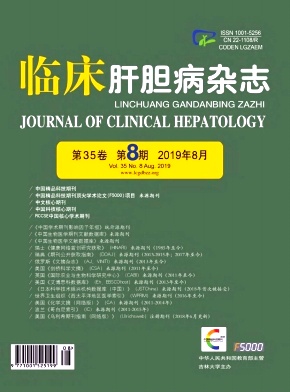|
[1] EL-SERAG HB, RUDOLPH KL. Hepatocellular carcinoma:Epidemiology and molecular carcinogenesis[J]. Gastroenterology, 2007, 132 (7) :2557-2576.
|
|
[2] LLOVET JM, MONTAL R, SIA D, et al. Molecular therapies and precision medicine for hepatocellular carcinoma[J]. Nat Rev Clin Oncol, 2018, 15 (10) :599-616.
|
|
[3] SOLE C, ARNAIZ E, MANTEROLA L, et al. The circulating transcriptome as a source of cancer liquid biopsy biomarkers[J]. Semin Cancer Biol, 2019.[Epub ahead of print]
|
|
[4] ZHONG Y, DU Y, XUE Y, et al. Circular RNAs function as ceRNAs to regulate and control human cancer progression[J]. Mol Cancer, 2018, 17 (1) :79.
|
|
[5] YAO R, ZOU H, LIAO W. Prospect of circular RNA in hepatocellular carcinoma:A novel potential biomarker and therapeutic target[J]. Front Oncol, 2018, 8:332.
|
|
[6] DONG Y, ZHANG X, XIE M, et al. Reference genome of wild goat (capra aegagrus) and sequencing of goat breeds provide insight into genic basis of goat domestication[J]. BMC Genomics, 2015, 16:431.
|
|
[7] ZHOU M, WANG X, SHI H, et al. Characterization of long non-coding RNA-associated ceRNA network to reveal potential prognostic lncRNA biomarkers in human ovarian cancer[J].Oncotarget, 2016, 7 (11) :12598-12611.
|
|
[8] WANG H, NIU L, JIANG S, et al. Comprehensive analysis of aberrantly expressed profiles of lncRNAs and miRNAs with associated ceRNA network in muscle-invasive bladder cancer[J]. Oncotarget, 2016, 7 (52) :86174-86185.
|
|
[9] TREIBER T, TREIBER N, MEISTER G. Regulation of microRNA biogenesis and its crosstalk with other cellular pathways[J].Nat Rev Mol Cell Biol, 2019, 20 (1) :5-20.
|
|
[10] SU Q, KUMAR V, SUD N, et al. MicroRNAs in the pathogenesis and treatment of progressive liver injury in NAFLD and liver fibrosis[J]. Adv Drug Deliv Rev, 2018, 129:54-63.
|
|
[11] ZHOU W, YANG WL, ZHANG HW, et al. Advances in the relationship between microRNA-483 and digestive system tumors[J]. Chin J Dig Surg, 2018, 17 (5) :522-526. (in Chinese) 周威, 杨万里, 张洪伟, 等.微RNA-483与消化系统肿瘤关系的研究进展[J].中华消化外科杂志, 2018, 17 (5) :522-526.
|
|
[12] LING H, FABBRI M, CALIN GA. MicroRNAs and other noncoding RNAs as targets for anticancer drug development[J].Nat Rev Drug Discov, 2013, 12 (11) :847-865.
|
|
[13] WONG CM, TSANG FH, NG IO. Non-coding RNAs in hepatocellular carcinoma:Molecular functions and pathological implications[J]. Nat Rev Gastroenterol Hepatol, 2018, 15 (3) :137-151.
|
|
[14] SU H, TAO T, YANG Z, et al. Circular RNA cTFRC acts as the sponge of MicroRNA-107 to promote bladder carcinoma progression[J]. Mol Cancer, 2019, 18 (1) :27.
|
|
[15] ZHANG X, WANG S, WANG H, et al. Circular RNA circNRIP1acts as a microRNA-149-5p sponge to promote gastric cancer progression via the AKT1/m TOR pathway[J]. Molecular cancer, 2019, 18 (1) :20.
|
|
[16] CAI M, XU L, SHEN L, et al. Expression of long-chain noncoding RNA FOXN3-AS2 in hepatocellular carcinoma and its effect on proliferation and invasion of hepatoma cells[J]. Chin J Clin Pharmacol Ther, 2018, 23 (11) :1246-1251. (in Chinese) 蔡民, 许浏, 沈兰, 等.长链非编码RNA FOXN3-AS2在肝癌中的表达及其对肝癌细胞增殖和侵袭的影响[J].中国临床药理学与治疗学, 2018, 23 (11) :1246-1251.
|
|
[17] ZHANG X, XU Y, QIAN Z, et al. CircRNA_104075 stimulates YAP-dependent tumorigenesis through the regulation of HNF4a and may serve as a diagnostic marker in hepatocellular carcinoma[J]. Cell Death Dis, 2018, 9 (11) :1091.
|
|
[18] BAI N, PENG E, QIU X, et al. CircFBLIM1 act as a ceRNA to promote hepatocellular cancer progression by sponging miR-346[J]. J Exp Clin Cancer Res, 2018, 37 (1) :172.
|
|
[19] CHENG Q, NING D, CHEN J, et al. SIX1 and DACH1 influence the proliferation and apoptosis of hepatocellular carcinoma through regulating p53[J]. Cancer Biol Ther, 2018, 19 (5) :381-390.
|
|
[20] CHEN JS, WANG Q, FU XH, et al. Involvement of PI3K/PTEN/AKT/m TOR pathway in invasion and metastasis in hepatocellular carcinoma:Association with MMP-9[J]. Hepatol Res, 2010, 39 (2) :177-186.
|
|
[21] LIU D, CUI L, WANG Y, et al. Hepatitis B e antigen and its precursors promote the progress of hepatocellular carcinoma by interacting with NUMB and decreasing p53 activity[J].Hepatology, 2016, 64 (2) :390-404.
|
|
[22] ZHANG ZY, HONG D, NAM SH, et al. SIRT1 regulates oncogenesis via a mutant p53-dependent pathway in hepatocellular carcinoma[J]. J Hepatol, 2015, 62 (1) :121-130.
|
|
[23] HUANG Q, LI J, XING J, et al. CD147 promotes reprogramming of glucose metabolism and cell proliferation in HCC cells by inhibiting the p53-dependent signaling pathway[J]. J Hepatol, 2014, 61 (4) :859-866.
|
|
[24] ZUO X, CHEN Z, CAI J, et al. 5-hydroxytryptamine receptor1D aggravates hepatocellular carcinoma progression through FoxO6 in AKT-dependent and independent manners[J].Hepatology, 2019, 69 (5) :2031-2047.
|
|
[25] CHEN Z, GAO W, PU L, et al. PRDM8 exhibits antitumor activities toward hepatocellular carcinoma by targeting NAP1L1[J]. Hepatology, 2018.[Epub ahead of print]
|
|
[26] LIU S, DU Y, MA H, et al. Preclinical comparison of regorafenib and sorafenib efficacy for hepatocellular carcinoma using multimodality molecular imaging[J]. Cancer Lett, 2019, 453:74-83.
|
|
[27] DENG H, SHANG W, LU G, et al. Targeted and multifunctional technology for identification between hepatocellular carcinoma and liver cirrhosis[J]. ACS Appl Mater Interfaces, 2019, 11 (16) :14526-14537.
|
|
[28] FAN YQ, DONG SL. Recent advances in targeted drug therapy for hepatocellular carcinoma[J]. J Clin Hepatol, 2018, 34 (2) :424-428. (in Chinese) 樊永强, 董胜利.靶向药物治疗肝细胞癌的最新进展[J].临床肝胆病杂志, 2018, 34 (2) :424-428.
|
|
[29] LIU Y, FENG J, SUN M, et al. Long noncoding RNA HULC activates HBV by modulating HBx/STAT3/miR-539/APOBEC3B signaling in HBV-related hepatocellular carcinoma[J]. Cancer letters, 2019, 454:158-170.
|
|
[30] MUKHERJI S, EBERT MS, ZHENG GX, et al. MicroRNAs can generate thresholds in target gene expression[J]. Nat Genet, 2011, 43 (9) :854-859.
|
|
[31] WEE LM, FLORES-JASSO CF, SALOMON WE, et al. Argonaute divides its RNA guide into domains with distinct functions and RNA-binding properties[J]. Cell, 2012, 151 (5) :1055-1067.
|







 DownLoad:
DownLoad: